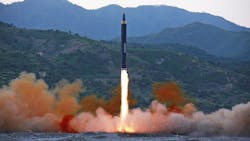U.S. military picks Corvid Technologies for software development for missile defense test and measurement
DAHLGREN, Va. – U.S. missile defense experts needed software support for a variety of ballistic missile defense tests. They found their solution from Corvid Technologies LLC in Mooresville, N.C.
Officials of the U.S. Missile Defense Agency (MDA) in Dahlgren, Va., announced a potential $44 million contract to Corvid Technologies on Thursday to provide mathematical algorithm development, computational analysis, and range safety analysis support for MDA flight tests.
The MDA's mission is to develop an integrated layered ballistic missile defense system to defend the U.S., its deployed forces, friends, and allies from ballistic missiles of all ranges and in all phases of flight.
The MDA's test and measurement program provides critical data to demonstrate the effectiveness, suitability, and survivability of the Ballistic Missile Defense System (BMDS).
Testing also contributes to U.S. non-proliferation goals by sending a credible message to the international community on U.S. ability to defeat ballistic missiles in flight.
Related: Test and measurement equipment keeps high-tech systems in working order
Testing is a continuous, evolutionary process that encompasses developmental and operational activities. The process begins with testing of system elements and components and progresses to end-to-end testing of the integrated system as a combination of interceptor and sensor systems linked by a sophisticated command and control architecture.
As testing progresses, each test builds on knowledge gained from previous tests, adds increasingly challenging goals, and becomes more operationally realistic.
The test program uses models and simulations to assess system configurations, engagement conditions, and target phenomena. Flight and ground testing provides essential data to validate the accuracy of models and simulations.
Ground tests combine hardware-in-the-loop, digital representations, high fidelity threat simulations, and operational assets to test BMDS capabilities across many threats and environments that cannot be replicated in flight tests.
Related: Raytheon to carry out revolutionary new test and measurement for SM-3 missile circuit cards
Exercises and wargames help military commanders prepare concepts of operations; tactics, techniques, and procedures; doctrine; and training on current and evolving BMDS capabilities.
Testing provides warfighters with confidence in the basic design of the BMDS, its hit-to-kill effectiveness, and its inherent operational capability.
MDA research seeks to establish and maintain the BMDS, add networked, forward-deployed ground-based, sea-based, and space-based sensors to make interceptors more effective in the future; expand U.S. missile-defense capability by adding interceptors over time; and add complex layers of increasingly capable sensors and weapons, as new technologies emerge.
Corvid Technology capitalizes on the predictive capability of high-fidelity computational physics solvers, an indigenous massively parallel supercomputer system, prototyping plant, and ballistics and mechanics lab to investigate high-rate physics phenomena, resulting in complex engineering solutions for ballistic missile defense, cyber security, aircraft, and missile and warhead design and development.
On this contract Corvid Technologies will do the work in Mooresville, N.C., and should be finished by June 2027. For more information contact Corvid Technologies online at www.corvidtec.com, or the Missile Defense Agency at www.mda.mil.

John Keller | Editor-in-Chief
John Keller is the Editor-in-Chief, Military & Aerospace Electronics Magazine--provides extensive coverage and analysis of enabling electronics and optoelectronic technologies in military, space and commercial aviation applications. John has been a member of the Military & Aerospace Electronics staff since 1989 and chief editor since 1995.

